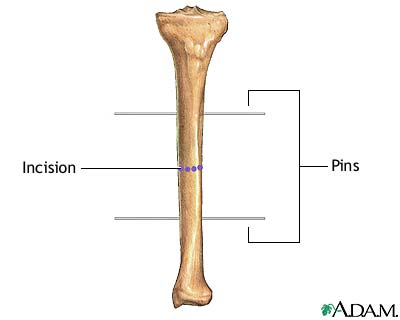Leg lengthening - series
Procedure

While the child is deep asleep and pain-free (using general anesthesia), the surgeons carefully study the blood vessels and blood supply to the bone. An incision is made in the bone to be lengthened; usually the lower leg bone (tibia) or upper leg bone (femur). Metal pins or screws are inserted into and through the skin and bone above and below the bone incision and the skin incision is stitched closed. A metal device (such as an Ilizarov device) is attached to the screws in the bone and will be used later to gradually "crank" the cut bone apart, creating a space between the ends of the cut bone, which heals to form new bone. The lengthening device is used very gradually, lengthening the bone in extremely small steps, usually over the course of several months.
Update Date: 11/12/2010
Updated by: Neil K. Kaneshiro, MD, MHA, Clinical Assistant Professor of Pediatrics, University of Washington School of Medicine. Also reviewed by David Zieve, MD, MHA, Medical Director, A.D.A.M., Inc.
Related Page
Notice: The information provided herein should not be used during any medical emergency or for the diagnosis or treatment of any medical condition. A licensed physician should be consulted for diagnosis and treatment of any and all medical conditions. Call 911 for all medical emergencies. Links to other sites are provided for information only -- they do not constitute endorsements of those other sites. Copyright 1997-2012, A.D.A.M., Inc. Any duplication or distribution of the information contained herein is strictly prohibited.
